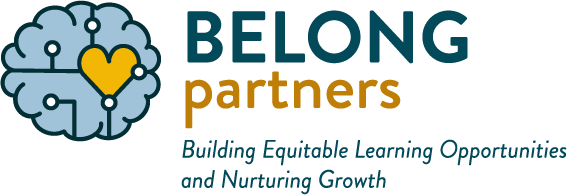When we say, “what if every child knew they belonged?”, what exactly do we mean?
 Recently, I explored this question over Zoom with Dr. DeLeon Gray, Associate Professor of Educational Psychology and Education Equity at North Carolina State University and a leading researcher on the intersection of race, belonging, and motivation in school.
Recently, I explored this question over Zoom with Dr. DeLeon Gray, Associate Professor of Educational Psychology and Education Equity at North Carolina State University and a leading researcher on the intersection of race, belonging, and motivation in school.
I learned about Dr. Gray’s work from Education Trust Research Associate Nancy Duchesneau. When Nancy and I talked about Sound Discipline’s investigation into belonging, she said, “Well then, you have to talk with DeLeon Gray. He is pretty much the leading voice on belonging.”
To learn more about Dr. Gray’s “Opportunities to Belong Framework,” check out his paper entitled Black and Belonging at School: A case for interpersonal, instructional, and institutional opportunity structures at school, or check out this video which helped me understand what his ideas mean in schools and classrooms. Here are some key takeaways:
Belonging is not one-size-fits-all; it is about esteeming and prioritizing cultural uniqueness and historical and political context in every aspect of the school ecosystem. In a community and school context that has historically erased and stigmatized Black and Brown students, a belonging framework infuses classrooms and schools with curriculum, expression, and student-led learning based on their histories, values, and cultural meaning. It turns out there is no such thing as a race-neutral curriculum.

Building a school culture that fosters a belonging ecosystem takes time and skill and must happen at all levels simultaneously. Dr. Gray describes these levels in terms of “opportunity structures.” The first opportunity structure is interpersonal — educators facilitating connection student to student, student to teacher, student to parent. Another is instructional — educators engaging with students in learning that reinforces and esteems their unique culture, and grounds learning in a historical and political context. The third is institutional opportunity — adults building structural supports that honor and lift up each person’s equal worth and inherent dignity.
Belonging connects with being able to connect self with a larger story. I asked Dr. Gray about the life path that led him to dedicate his life to supporting other kids like him to feel true belonging. Here is what he shared:

“I went to predominantly Black schools all my life. My first experience was an elementary school in the northwest part of Washington DC. We used my grandmother’s address so I could go to that school. Later on, I learned that my grandmother had been a sharecropper in North Carolina. She migrated to DC to find a way forward. There, she cleaned houses. The family she cleaned for thought she was so sweet they gave her their house at a highly discounted rate. The address and ZIP code of this house made it possible for me, my brother, and my cousins to gain access to our elementary school. This school had a partnership with Howard University. In fact, it was on their campus. I was surrounded by Black leaders, by examples of service and engagement. I got to see the role universities could play in the life trajectories of school-aged children, and it gave me a vision for what I could do. I was in a science and tech program, and always involved in athletics. My coach was an Alpha. He took an interest in me. I pledged Alpha in college. All of this gave me particular exposure to education and it also gave me protection. My confidence had not been shaken compared to other youth who because of racism and systemic barriers came to question their alignment with their environment. In my growing up, I got to experience belonging. When I went to college, I compared my experiences with some of my contemporaries. It hit me hard. I look at the Black church too. I was raised on Black liberation theology. My home church in DC has a mural behind the altar with a painting of Black Jesus surrounded by a pantheon of Black visionaries and activists. That’s what I saw every week. That reinforced in me the idea of achieving for social impact and not just rising for my career. It’s hard for someone to tell me that I don’t matter because WE MATTER.”
At Sound Discipline, our partnerships and support of educators and parents connect with all three opportunity structures, and we are constantly learning. Dr. Gray’s scholarship and collaboration with educators helps us name why this is so important and why we lift up and amplify Black and Brown voices who are leading and showing the way.
Sound Discipline partners with educators, organizations, and families to transform schools into equitable learning communities.
We bring together science-based, trauma-informed, restorative, and Positive Discipline practices to facilitate change in the ways adults see and respond to students.
Courageous Educators:
We facilitate school leaders and educators to build classroom communities and model an inclusive culture school-wide that promotes student agency and well-being.
Equitable School Systems:
We coach administrators and educators to use data to identify and implement solutions that address damaging systemic patterns of inequity that target Black and Brown students.
Connected Families:
We train and coach families and caregivers in a child’s life to apply solution-oriented practices that instill critical social emotional life skills.
